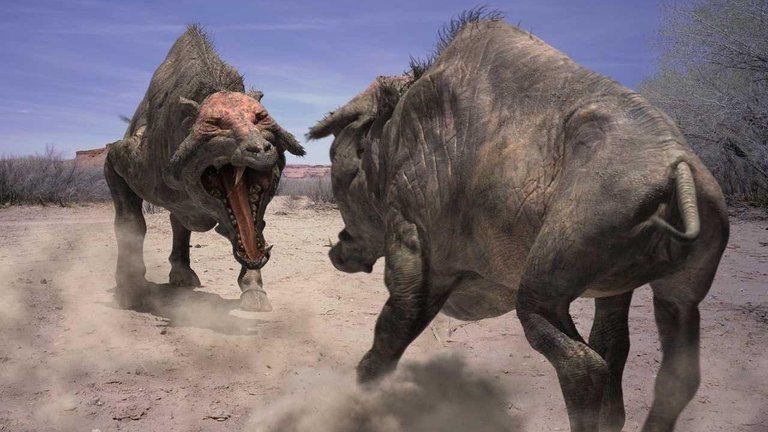
For much of the 20th century, the BBC stood as an institution synonymous with pioneering television excellence, combining educational rigour with mass appeal. By the century’s close, it cemented this reputation with Walking with Dinosaurs (1999), a landmark documentary series that redefined natural history programming through cutting-edge CGI, immersive storytelling, and cinematic ambition. Its critical and commercial triumph—garnering BAFTAs, Emmys, and global acclaim—made a sequel inevitable. In 2001, the BBC delivered Walking with Beasts, a six-part exploration of the Cenozoic era, which sought to replicate the magic of its predecessor while shifting focus to the rise of mammals after the dinosaurs’ demise. While the series retained much of Dinosaurs’ formula, it also grappled with the challenges of evolving scientific understanding, technical limitations, and the burden of high expectations.
Series creator Tim Haines opted for a logical narrative continuation, opening Walking with Beasts with the aftermath of the Cretaceous-Paleogene extinction event—a cataclysmic meteorite strike that eradicated the Mesozoic giants. This framing device, depicted in the prelude to the first episode, transitions viewers into the Cenozoic, an era dominated by mammals, birds, and other “beasts” that filled ecological niches left vacant by dinosaurs. Haines’ decision to focus on this underappreciated epoch was both ambitious and necessary, given the relative obscurity of Cenozoic fauna compared to their dinosaurian predecessors. However, the series’ subtitle—Walking with Prehistoric Beasts—subtly acknowledges that “beasts” encompasses more than mammals, including terror birds, marine reptiles, and early primates, reflecting the era’s biodiversity.
True to the adage “if it isn’t broken, don’t fix it,” Walking with Beasts adhered closely to the structure of its predecessor. Six 30-minute episodes, each set in distinct epochs and locales, showcased specific animals and their struggles. This episodic format allowed for narrative depth but occasionally constrained broader evolutionary storytelling. For instance, New Dawn (Eocene Germany) introduces Leptictidium, a shrew-like biped, and Gastornis, a predatory bird, in a lush, post-apocalyptic jungle. Meanwhile, Whale Killer (Late Eocene Pakistan) tracks Basilosaurus, an early whale, navigating the shrinking Tethys Sea. Such vignettes prioritise intimate storytelling over systemic exploration of ecological shifts, a double-edged sword that enhances drama but risks oversimplification.
Each episode’s distinct tone and setting underscores the series’ strengths and weaknesses:
- New Dawn (49 million years ago, Germany): Brutal and claustrophobic, this opener juxtaposes Leptictidium’s fragility against volcanic eruptions and predatory birds. Its violent climax—a limnic eruption—echoes real-world disasters like Lake Nyos, blending spectacle with scientific plausibility.
- Whale Killer (36 million years ago, Pakistan): A drier, more desolate landscape frames Basilosaurus’ marine dominance, though its portrayal as a hyper-aggressive predator has since been contested by studies suggesting a more piscivorous diet.
- Land of Giants (25 million years ago, Mongolia): Sentimental and grand, this episode follows an Indricotherium calf’s survival—a narrative choice criticised for anthropomorphism but praised for emotional resonance.
- Next of Kin (3.2 million years ago, Ethiopia): Focusing on Australopithecus, this episode’s CGI hominins appear uncanny compared to practical effects in later BBC works like Walking with Cavemen .
- Sabre Tooth (1 million years ago, Paraguay): Highlights Smilodon amidst South America’s unique megafauna, though its speculative social dynamics remain contentious.
- Mammoth Journey (30,000 years ago, Europe): A poignant finale connecting Ice Age mammoths to early humans, marred slightly by dated Neanderthal prosthetics.
The series’ commitment to narrative often clashes with scientific fidelity. While Walking with Beasts boasted rigorous research—consulting palaeontologists and fossil evidence—creative liberties were inevitable. For example, Andrewsarchus, depicted as a wolf-like mesonychid, is now believed to be closer to entelodonts or hippos. Similarly, Ambulocetus’s aquatic prowess, central to Whale Killer, relies on incomplete fossils, with later studies questioning its transitional role. Such inaccuracies, while understandable given 2001-era knowledge, highlight the pitfalls of blending documentary with drama. Yet, the series excels in visualising climate change’s impact, such as the Eocene-Oligocene cooling in Land of Giants, grounding speculative narratives in geological reality.
The series’ technical achievements are commendable but uneven. Kenneth Branagh’s narration and Ben Bartlett’s score—reminiscent of Dinosaurs—provide continuity, yet the CGI and animatronics faced greater scrutiny. Mammals’ fur, feathers, and facial expressions posed challenges: Smilodon’s kittens and Australopithecus appear stiff compared to the lifelike woolly mammoths. Animatronics, while innovative (e.g., Gastornis puppets), struggled with realism in close-ups. The decision not to use actors in prosthetics for hominins in Next of Kin, backfired, evoking comparisons to Stanley Kubrick’s 1968 2001: A Space Odyssey—hardly a compliment for a 2001 production.
Despite its shortcomings, Walking with Beasts remains a landmark in paleontological storytelling. Its finale, Mammoth Journey, ingeniously bridges prehistoric and human history, emphasising continuity over catastrophe. While later discoveries have dated some portrayals, the series’ ambition to illuminate the Cenozoic’s “forgotten” epochs deserves acclaim. For all its technical growing pains and speculative leaps, Walking with Beasts succeeded in making audiences care about creatures like Indricotherium and Basilosaurus—no small feat for a world without dinosaurs. In doing so, it upheld the BBC’s legacy of marrying education with entertainment, even if it never quite escaped the shadow of its iconic predecessor.
RATING: 7/10 (+++)
Blog in Croatian https://draxblog.com
Blog in English https://draxreview.wordpress.com/
InLeo blog https://inleo.io/@drax.leo
Hiveonboard: https://hiveonboard.com?ref=drax
InLeo: https://inleo.io/signup?referral=drax.leo
Rising Star game: https://www.risingstargame.com?referrer=drax
1Inch: https://1inch.exchange/#/r/0x83823d8CCB74F828148258BB4457642124b1328e
BTC donations: 1EWxiMiP6iiG9rger3NuUSd6HByaxQWafG
ETH donations: 0xB305F144323b99e6f8b1d66f5D7DE78B498C32A7
BCH donations: qpvxw0jax79lhmvlgcldkzpqanf03r9cjv8y6gtmk9
Posted Using INLEO